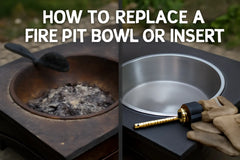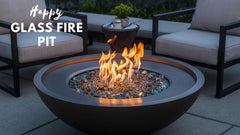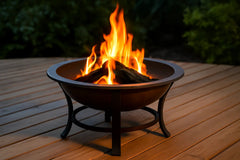Fire Pit Safety on Wooden Decks: What You Need to Know
A wooden deck can be turned into a cosy shelter by adding warmth, charm, and ambience to outdoor evenings with a fire pit. However, despite the no doubt in the appeal, there are grave safety dangers that are associated with installing a fire pit on wood. Fire hazards exist and need to be considered even before you grope the matchstick. Educating yourself on the safety precautions you should follow will make sure you have fun in your fire pit and keep your deck and home safe.
Why Wooden Decks Need Extra Caution
Wooden decks are naturally inflammable as opposed to stone patios. Even treated wood cannot resist high temperatures and fire. The dilemma is how to find the balance between enjoying an outdoor fire and lumbering your deck, or even worse, triggering a fire emergency. This renders planning and installation vital prior to utilization of any fire pit. For a deeper understanding, you can refer to the Fire Pit Safety Tips.
Choosing the Right Fire Pit
Not every fire pit will fit on wooden decks. Legged portable models are safer because the flames are raised off the wood. Gas fire pits are commonly used since they are easier to burn and have more control over the size of the flame. Pits that burn wood can remain without modifications, although they require extra safety measures in the form of spark screens and heat shields. You should always ensure that the fire pit you select is rated to be used on deck. For more details, visit Fire Pits on Wood Decks: What You Should Know.
The Heat Shields and Pads.
The initial defence mechanism against your deck is a heat shield or fire resistant pad. These fittings eliminate the scalding or burning effects of radiant heat on the wood underneath. They are made to resist high temperatures with embers being caught before they can sink into gaps in the deck. There is no way you can afford not to invest in one should you be willing to use a fire pit frequently on your deck.
Proper Placement Matters
The location of your fire pit may be the difference. It must be in the middle of the deck and not near railings, siding or hanging branches. It is advisable to maintain a minimum distance of 10 feet to the clearance on all sides so as to minimize chances of sparks coming into contact with flammable objects. When you have a small deck, then you might have to reconsider and decide if a fire pit will be the best choice. For guidelines on fire safety placement, refer to the Fire Pit Safety Checklist
Firewood and Fuel Safety
The type of fuel you use has a direct influence on deck safety. Hardwoods that are dry and seasoned also do not generate sparks as often as softwoods, lowering the chances of rogue embers. Do not use a lighter fluid or accelerants that burst very easily. When utilizing a gas fire pit, make frequent inspections on connections and hoses to determine if they are leaking or damaged. Safe fuel burning will not only save your deck, but also burn cleaner.
With Sparks and Embers Bobbin.
One of the largest hazards of a wooden deck is flying sparks. An ember-catching mesh spark screen can be placed over the pit but a fire pit cover is used when not in use. It is also a good idea to have a bucket of water or fire extinguisher in the vicinity in case the sparks fall in the wrong place. The net of these small steps forms a very necessary safety net.
Always Turn Flames off
This may sound easy, but most deck fires begin with flames ignited without any supervision. Never leave your fire until it is out. Even embers that are burning out can re-ignite and do damage hours later. Pouring water over the fire and stirring up the ashes is enough before you move into the house.
Weather Awareness
The wind has the ability to change a safe fire into a hazardous condition within just a few seconds. Powerful winds carry sparks too far out to the side of your deck, and dry weather increases the danger of fire. Be sure to check the weather forecast before lighting your fire pit and do not use it on windy or drought-prone days. Timing concerns are equally significant to the fire pit.
Long-Term Deck Protection
Planning to use your fire pit very often, you may think about improving your deck materials. Fire resistant composite decking offers an extra level of safety and stone inlays will offer a special fire-safe area. Consistent deck care like sealing, cleaning of the deck also helps in deterring stray embers that may be taking root.
Final Safety Checklist
-
In a pre-lighting fire pit checklist, ask yourself:
-
Is the fire pit sound and steady?
-
Is there any heat-resistant barrier underneath?
-
Is flammable clearance safe?
-
Are fire safety tools nearby?
Spending one minute to verify these factors every time you utilize your fire pit would help a great deal to minimize dangers.
FAQs
Is it possible to place a fire pit directly on my wooden deck?
No. Direct placement will be prone to heat damage and fire. A fire pit pad or heat shield should always be used.
Are gas fire pits better than wood burning ones?
As a rule yes, since they cause controlled fires and a lower number of sparks, but precautions should be taken anyway.
How do I work with embers that are on my deck?
Put them out with water. Wood can be ignited by even a small ember when you are not watching.
What distance do fire pits need between my house and them?
A minimum of 10 feet is desired (where feasible), but additional distance is preferable.
Conclusion
With the help of a fire pit, your wooden deck can become a comfortable and cozy outdoor environment, although safety should always come first. Fire and wood are a deadly mixture which is to be carefully planned, equipped, and watched over. A suitable fire pit, some heat shields prepared on the deck, and vigilance during the fire will allow you to enjoy the radiation of the flames without endangering your home. Safe partying makes your fire pit something you are comfortable with and not something to worry about.






